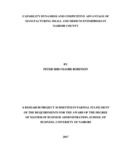| dc.contributor.author | Maobe, Robinson PS | |
| dc.date.accessioned | 2018-02-05T08:31:41Z | |
| dc.date.available | 2018-02-05T08:31:41Z | |
| dc.date.issued | 2017 | |
| dc.identifier.uri | http://hdl.handle.net/11295/103305 | |
| dc.description.abstract | In today’s highly competitive business operating environment, firms have increasingly used sustainable strategic management practices to survive the intensive competition. SMEs operate in an environment that may impact both positively and negatively on their pursuit of strategies. Small and Medium Enterprises (SMEs) may develop competitive advantage through combination of resources that support their competitive position in the marketplace. Capability dynamism may lead to strategic investment processes by the SMEs which can lead to increased costs. The main objective of the study will be to establish the relationship between capability dynamism and competitive advantage of manufacturing SMEs in Nairobi. This study adopted a descriptive research design to achieve its objectives. Both primary and secondary data were used. Questionnaire was used as the main research instrument. Data collected was analysed quantitatively. The findings indicated that may of the SMEs spent between Ksh 1.1 million to Ksh 5million on research and development but majority of them spend less than Ksh 1 million on training. The respondents also indicated that to a large extent that their organization uses managers to combine their varied skills to create revenue producing products and services and use resource allocation routines to distribute scarce resources such as manufacturing assets from central points within the hierarchy. The respondents agreed to a large extent that managers use knowledge creation routines to build new thinking within the firm. It was also established that scanning the environment for opportunities & threats is also always implemented while access to external science & technology is occasionally implemented. The study concludes that organizations that developed capability dynamism have competitive advantage over their rivals. It is recommended that in order to reduce the failure rate of newly established firms, awareness needs to be created regarding the benefits related to extensive use of advanced technologies. Costs could be reduced by government intervention in reducing customs and excise taxes on ICT, while vendors could increase awareness campaign to SMEs. Kenyan SMEs need to move from the level of acquiring VRIN resources to developing dynamic capabilities. SMEs are therefore encouraged to develop sensing, seizing and reconfiguration capabilities to remain competitive. | en_US |
| dc.language.iso | en | en_US |
| dc.publisher | University of Nairobi | en_US |
| dc.rights | Attribution-NonCommercial-NoDerivs 3.0 United States | * |
| dc.rights.uri | http://creativecommons.org/licenses/by-nc-nd/3.0/us/ | * |
| dc.subject | Manufacturing Small and Medium Enterprises | en_US |
| dc.title | Capability Dynamism and Competitive Advantage of Manufacturing Small and Medium Enterprises in Nairobi County | en_US |
| dc.type | Thesis | en_US |



